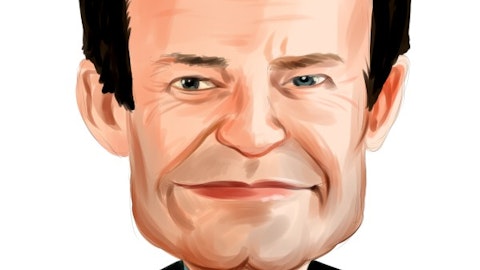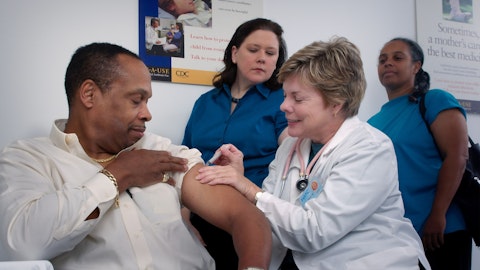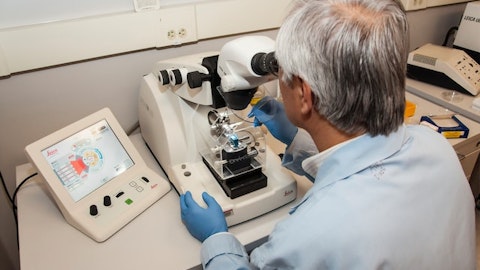Is that true? Has that changed? And if there is a question of capturing the upside from those switches, does that impact the pathway that you will take for the divestment of the Consumer business. So potentially, would you consider keeping a stake beyond an initial spin? .
Paul Hudson: And Simon, JB, the relative weight of the components on the ’24 performance of R&D commercial investments, Gen Med pricing and perhaps even tax, which wasn’t mentioned. .
Jean-Baptiste de Chatillon: Well, tax is 200 bps. So that’s well publicized. I would say, on a repeat, the bulb of it is a pipeline. Of course, we have also some other topics around Gen Med, around as a stand-alone cost of consumer health, backing our launches, which are successful, so all of this play a part. But remember, top line growth is untouched. Strong rebound from ’25 onwards. On the D versus R, I would say that that’s an important point. And of course, it’s maybe more an answer for — but from a financial point of view, in terms of risk appraisal, you’ve noticed that the bulk of our I&I pipeline is in its D phase and we are going to double down on investing in a pretty high POS portfolio versus just increasing massively just R, so that’s an important thing to keep in mind when you look at our risk profile.
And regarding the switches, it’s not so much a binary piece, but we’ll keep in mind, everything you’ve said today, and it’s an interesting feedback, but it’s too early to say which we would take.
Paul Hudson: Thank you — did you have anything?
Unidentified CompanyParticipant: Yes. quickly, Simon, thank you for the question. So there’s no doubt that we’re going to double down on D internally. We’re excited about D, including molecules like [indiscernible] and small molecule TNF that Paul has already referred to. But I just want to double underline that actually, we have huge confidence in our early pipeline, both internally, but also our external media activity that will feed the pipeline. You’ll have seen today at 7 a.m. ESG announcement from Chimera, one of our partners that the Chimera 474 molecules just gone into Phase II or — inhibition, but had radenivis separativa So the short answer to your question is while we are confident about our late-stage development pipeline, we remain excited about our own internal and partnered activity, but we will be mindful through the reallocation of spending every dollar wisely. And that’s the opportunity I’ve had when I started. Thank you. .
Paul Hudson: I think yes, we [indiscernible] just announced. Today, [indiscernible], that’s great news. That’s another shot on goal we’ve got as we go into Houman’s in HS. Okay. Any other questions?
Eva Schaefer-Jansen: Yes. Next question is from Seamus Fernandez from Guggenheim.
Seamus Fernandez: Thanks for the question. So just two quick ones. Should we basically signal today’s announcements as suggesting that you have enough in-house and that you’re really investing on the internal side of the business going forward via the recently acquired pipeline or do you have further interest in going externally for deals. We’ve seen a lot of speculation that Sanofi has been extremely active in potential business development. And I guess the concern here is that, that could also contribute meaningfully to R&D spend should you move towards, especially high plus — acquisitions that are potentially dilutive to the business. So should we be thinking about that as R&D-oriented deals or potentially accretive deals, if that’s where Sanofi’s plan?
And then the second question is just really I think there’s this assumption that you’ve basically kind of taken the consensus number for earnings down 13% to 15% in 2025. So I think a lot of the questions that folks are fielding right now, are trying to get a sense of the magnitude of that earnings rebound. And just how deep the BOI change is actually going. So if there’s any color that you can offer on that, removing 32% doesn’t necessarily mean that we’re also guaranteeing about 31% or hopeful to achieve better than 30%. So any help there would be fantastic. .
Paul Hudson: Okay. Well, I think, firstly, on the question on the R&D spend. I think you sort of say is it internal programs or are we made provision, if you like, for to do M&A? I think it’s just worth clarifying for everybody that we have as significantly increasing confidence in our own pipeline. We don’t carry placeholders for just in case. We are very, very comfortable that we have a lot in our own pipeline that can deliver transformational value creation in the Company period. . But that said, we have to work very hard, like we did with the recent Teva deal on the TL1A or the E.coli deal with Janssen that we have to — where we want to tuck something in, we have to make a little space for that to get it done. That’s discipline.
So I think it’s also worth being clear because we haven’t given a number for ’25, yes, we’ve increased some flexibility for us, but it would be a mistake for people to think that we’re not maintaining or increasing discipline. The discipline and to continue to improve the operational efficiency of the Company is an absolute priority. But what we didn’t do was dimensionalize it because we want to get on with the work and create the value. So — and I think you’ll see that reveal itself over time, but today is not the day for that. So J.B., is there anything to add on.
Jean-Baptiste de Chatillon: I think it’s important to repeat that we are keeping intact our capital allocation, of course, provide dividend and so on and so forth, but on the organic growth. And I think we’ve demonstrated in the last two years, that if we are looking at something opportunistic, it will not be idly dilutive and it has to be very well priced on value generative for shareholders as of day 1. So that’s pretty clear. . On the margin, I think it’s with a low decline — a slow decline, a small decline, sorry, in ’24 with — on the flattish without effective tax rate impact, it gives a very clear view what — from that base, 2025 would be meaningful on a very strong rebound. .
Paul Hudson: Yes. And that strong rebound. I don’t know everybody is would like to see us put a number on it and dimensionalize it. And it’s already been mentioned on the call, the 32%, which we guided back in 2019. If you think how far we’ve come, I think what management is saying fully supported by our Board is that we’ve earned the right for some flexibility, but it doesn’t change our desire to run a more profitable more valuable Company. That simply hasn’t changed. What we’ve done is given ourselves — we’ve widened the bookends to create more value. So I think if you think it’s freestyle. I just want to correct any misunderstanding about that because that is just simply not the case, if anything, for our leaders in the Company, there is an acute awareness of our ability to demonstrate year-on-year and a more interesting compelling operational story.
So that is simply not going away. Recognizing in your world, you can’t put that in a model, but you have to understand in my world, I need to create the most value for shareholders and patients that possibly can. And that’s why we find ourselves probably saying the same thing without being able to give you a number to reassure you. But you — we have to know that we’re betting on ourselves in this moment. We have a lot of confidence in that. I think maybe we go to the last question.




